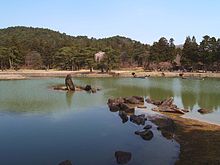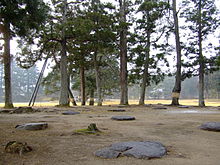- Mōtsū-ji
-
Mōtsū-ji (毛越寺)refers to the Buddhist temple of the Tendai sect in Hiraizumi and to the historic area surrounding it containing the ruins of two older temples, Enryū-ji (圓隆寺) and Kashō-ji(嘉祥寺)in a Jōdo (Pure Land) garden. The current temple was built in the 18th century and bears no relation to the ancient temples that once stood here. In June 2011, Mōtsū-ji was listed as a UNESCO World Heritage Site as "Historic Monuments and Sites of Hiraizumi".
Previous to the 12th century this area was apparently known as Mōtsū, or Kegosu being an alternate reading of the Chinese characters 毛越. These characters mean 'hair' and 'boundary' and refer to the boundary between Japan and the 'hairy people' or Emishi beyond. In other words this was at one time the northern boundary of Japan.
In the mid 12th century Fujiwara no Motohira, the second Northern Fujiwara lord, built a temple here called Enryũ-ji. There is also a possibility that Motohira's father Fujiwara no Kiyohira built an earlier Enryū-ji on this site before he died in 1128. If so, it is supposed that this original temple was consumed by fire soon after its completion in the war of succession between Motohira and his brother Koretsune. The temple built by Motohira around 1150 would then have been a copy of his father's temple.
Motohira's Enryũ-ji must have been spectacular by any standards. The main hall contained a monumental statue of Yakushi, the Buddha of Healing, with monumental statues of the Twelve Divine Generals (Jūni Shinshō). They had been sculpted by Unkei with crystal eyes; an innovation at that time. The hall itself was brightly painted and decorated with precious wood, gold, silver and jewels. The main temple was surrounded by other buildings including a lecture hall, a circumambulation hall, a two story main gate, a bell tower and a sutra repository. The temple's name placard was written by Fujiwara no Tadamichi (藤原忠通) and the ornamental poem slips by Fujiwara no Norinaga.
Once Enryũ-ji was completed Motohira ordered an exact copy to be built beside it, Kashō-ji. He did not live to see it completed. His son and heir, Hidehira, accomplished that task. Kashō-ji also contained a monumental statue of Yakushi but the walls were decorated with paintings illustrating the Lotus Sutra.
At the height of its glory Mōtsū-ji is said to have had 40 pagodas and 500 monasteries. But all was burned in November 1226 and never rebuilt.
Today the pond is preserved much as it was 800 years ago, but none of the original buildings exist today nor have been rebuilt. The new Motsu-ji temple sits in front of the 12th century site straddling what used to be Kuramachi Street. Now there are beautiful plantings of cherry trees, irises, lotus, bush clover and maples. Various festivals are held throughout the year. Admission is 500 yen for adults. Directly to the east across the Frontier Way Motohira's wife built Kanjizaiō-in.
Annual events include -
- January 20 = The Jogyodo 20th Night Festival and 'Ennen no Mai Dance
- May 1–5 = Spring Fujiwara Festival and Ennen no Mai Dance
- June 20 - July 10 = Ayame Matsuri or Iris Festival
- August 16 = Daimonji Matsuri or Bon Fire Festival
- September 15–30 = Hagi Matsuri or Japanese Bush Clover Festival
- November 1–3 = Autumn Fujiwara Festival and Ennen no Mai Dance
See also
- List of Special Places of Scenic Beauty, Special Historic Sites and Special Natural Monuments
External links
- Motsuji Temple (English Web Site)
38°59′16″N 141°06′29″E / 38.987817°N 141.108022°ECoordinates: 38°59′16″N 141°06′29″E / 38.987817°N 141.108022°E
Buddhist temples in Japan Japanese Buddhist architecture Architectonic elements Mon (gates) Buildings Chinjusha · chōzuya/temizuya · -dō · main hall (kon-dō, hon-dō, butsuden) · kuri · kyōzō or kyō-dō · shoinTō or Buttō (pagodas) Styles Others A-un · kenSchools and objects of worship Major schools Zen schools Nanto rokushū Objects of worship Amida Nyōrai · Benzaiten · Dainichi Nyorai · Jizō · Kannon · Marishi-ten · Shaka Nyorai · Shitennō (Four Kings) · Twelve Heavenly Generals (Jūni Shinshō) · Yakushi NyoraiOther elements Implements kei (ritual gong) · mokugyōOthers bussokuseki · butsudan · Glossary of Japanese Buddhism · Japanese Buddhist pantheon · jingū-ji · miyadera · saisenbakoCategories:- Buddhist temples in Iwate Prefecture
Wikimedia Foundation. 2010.



